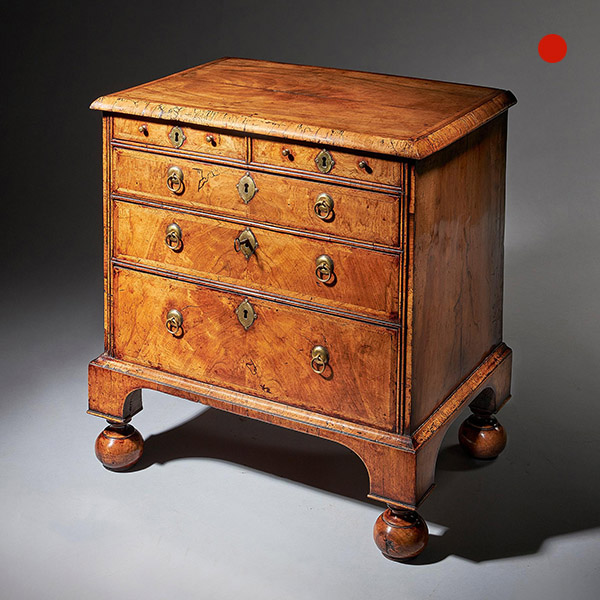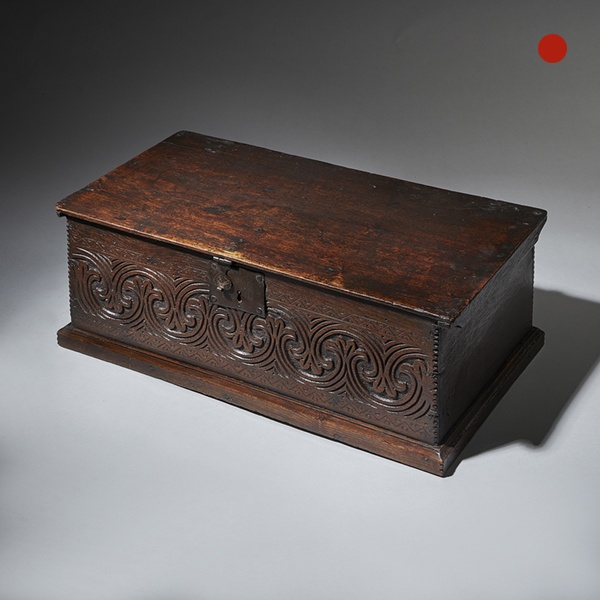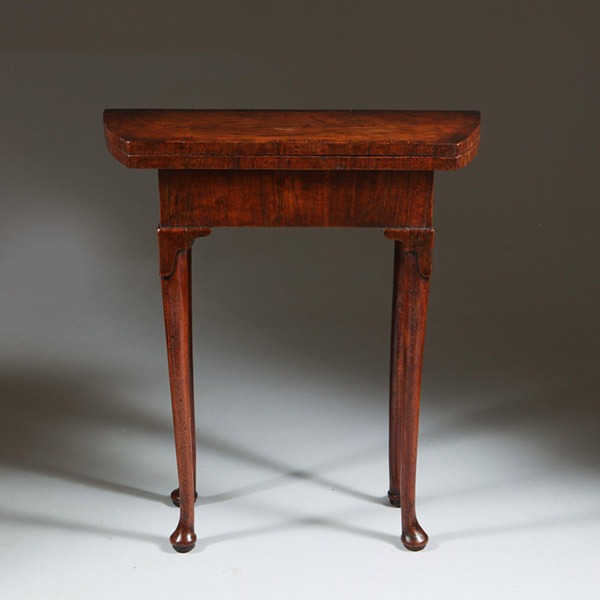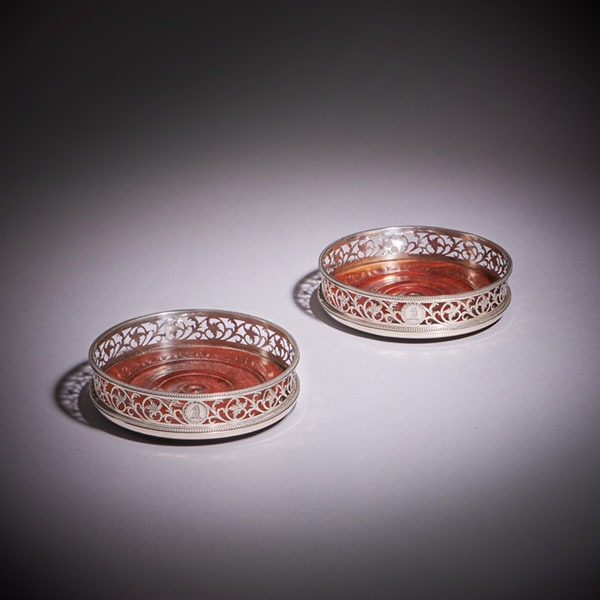18th Century George II Chippendale Period Two Door Mahogany Glazed Bookcase
Sold
Request Information
Follow Us
18th Century George II Chippendale Period Two Door Mahogany Glazed Bookcase
The fine dentil cornice sits above a pair of glazed doors. The doors are decorated with moulded glazing bars in the typical manner associated with Thomas Chippendale and open to the original adjustable shelves.
The low waisted moulded base is fitted with a pair of raised and fielded panelled doors, concealing the two original adjustable shelves and raised on bracket feet.
Both the upper and lower sections of the bookcase appear to be fitted with the original gilt-brass carrying handles, escutcheons, locks and catches.
Outstanding colour and patination.
Condition
Good. Wear consistent with age and use.
Dimensions
Height: 84.26 in. (214 cm)
Width: 42.52 in. (108 cm)
Depth: 19.69 in. (50 cm)
PREVIOUSLY SOLD

Extremely Rare and Fine Miniature Kingwood Table Cabinet from the Reign of Charles II
Extremely Rare and Fine Miniature Kingwood Table Cabinet from the Reign of Charles SOLD Follow UsExtremely Rare and Fine Miniature Kingwood Table Cabinet from the Reign of Charles Extremely rare and fine miniature kingwood table cabinet from...

An extremely rare George I walnut chest of small proportions on ball and bracket
An extremely rare George I walnut chest of small proportions on ball and bracket SOLD Follow UsAn extremely rare George I walnut chest of small proportions on ball and bracket The cross-grain moulded and feather banded book-matched top sits...

Fine and Rare Late 17th Century William and Mary Olive Oyster Lace Box
Fine and Rare Late 17th Century William and Mary Olive Oyster Lace Box Sold Follow UsFine and Rare Late 17th Century William and Mary Olive Oyster Lace Box A fine and rare late 17th century olive oyster 'lace box from the reign of King...

Late 17th Century Charles II Carved Oak Bible Box, Deed Box, Blanket Box,or Candle Box
Late 17th Century Charles II Carved Oak Bible Bo, Deed, Blanket, or Candle Box Sold Follow UsLate 17th Century Charles II Carved Oak Bible, Deed, Blanket, or Candle Box A superb and original late 17th century oak box with excellent and deep...

18th Century George II Mahogany Miniature Bureau
18th Century George II Mahogany Miniature Bureau SOLD Follow Us18th Century George II Mahogany Miniature Bureau What came first.... the miniature or the full scale? This small scale model at just 9” wide dates from the very beginning of the...

17th Century Charles II Cocuswood Lace Box, Circa 1660, England
17th Century Charles II Cocuswood Lace Box, Circa 1660, England SoldFollow Us17th Century Charles II Cocuswood Lace Box, Circa 1660, England An extremely rare and important Cocuswood oyster (Brya ebenus) lace box from the reign of Charles II,...

Extremely Rare and Fine Miniature Kingwood Table Cabinet from the Reign of Charles II
Extremely Rare and Fine Miniature Kingwood Table Cabinet from the Reign of Charles SOLD Follow UsExtremely Rare and Fine Miniature Kingwood Table Cabinet from the Reign of Charles Extremely rare and fine miniature kingwood table cabinet from...

An extremely rare George I walnut chest of small proportions on ball and bracket
An extremely rare George I walnut chest of small proportions on ball and bracket SOLD Follow UsAn extremely rare George I walnut chest of small proportions on ball and bracket The cross-grain moulded and feather banded book-matched top sits...

Fine and Rare Late 17th Century William and Mary Olive Oyster Lace Box
Fine and Rare Late 17th Century William and Mary Olive Oyster Lace Box Sold Follow UsFine and Rare Late 17th Century William and Mary Olive Oyster Lace Box A fine and rare late 17th century olive oyster 'lace box from the reign of King...

Late 17th Century Charles II Carved Oak Bible Box, Deed Box, Blanket Box,or Candle Box
Late 17th Century Charles II Carved Oak Bible Bo, Deed, Blanket, or Candle Box Sold Follow UsLate 17th Century Charles II Carved Oak Bible, Deed, Blanket, or Candle Box A superb and original late 17th century oak box with excellent and deep...

18th Century George II Mahogany Miniature Bureau
18th Century George II Mahogany Miniature Bureau SOLD Follow Us18th Century George II Mahogany Miniature Bureau What came first.... the miniature or the full scale? This small scale model at just 9” wide dates from the very beginning of the...

17th Century Charles II Cocuswood Lace Box, Circa 1660, England
17th Century Charles II Cocuswood Lace Box, Circa 1660, England SoldFollow Us17th Century Charles II Cocuswood Lace Box, Circa 1660, England An extremely rare and important Cocuswood oyster (Brya ebenus) lace box from the reign of Charles II,...
YOU MAY ALSO LIKE

A Fine Early 18th Century George I Burr Walnut Bureau Bookcase, Circa 1715
A Fine Early 18th Century George I Burr Walnut Bureau Bookcase, Circa 1715 £11,500Follow UsA Fine...

A Unique Early 18th Century Diminutive George I Figured Walnut Bachelors Table
A Unique Early 18th Century Diminutive George I Figured Walnut Bachelors Table £12,800Follow UsA...

A Fine 18th Century George II Mahogany Marble Topped Console Table, Ireland
A Fine 18th Century George II Mahogany Marble Topped Console Table, Ireland SoldFollow UsA Fine...

A Fine Pair of 18th Century George III Silver Engraved Open Fret Wine Coasters
A Fine Pair of 18th Century George III Silver Engraved Open Fret Wine Coasters £3,600Follow UsA...

A Large 18th Century George I Gilt-Gesso Pier Glass, Attributed to John Belchier
A Large 18th Century George I Gilt-Gesso Pier Glass, Attributed to John Belchier £42,000Follow UsA...

17th Century William and Mary Floral Marquetry Olive Oyster Lace Box, Circa 1685
17th Century William and Mary Floral Marquetry Olive Oyster Lace Box, Circa 1685 £16,000Follow...

A Fine Early 18th Century George I Burr Walnut Bureau Bookcase, Circa 1715
A Fine Early 18th Century George I Burr Walnut Bureau Bookcase, Circa 1715 £11,500Follow UsA Fine...

A Unique Early 18th Century Diminutive George I Figured Walnut Bachelors Table
A Unique Early 18th Century Diminutive George I Figured Walnut Bachelors Table £12,800Follow UsA...

A Fine 18th Century George II Mahogany Marble Topped Console Table, Ireland
A Fine 18th Century George II Mahogany Marble Topped Console Table, Ireland SoldFollow UsA Fine...

A Fine Pair of 18th Century George III Silver Engraved Open Fret Wine Coasters
A Fine Pair of 18th Century George III Silver Engraved Open Fret Wine Coasters £3,600Follow UsA...

A Large 18th Century George I Gilt-Gesso Pier Glass, Attributed to John Belchier
A Large 18th Century George I Gilt-Gesso Pier Glass, Attributed to John Belchier £42,000Follow UsA...

17th Century William and Mary Floral Marquetry Olive Oyster Lace Box, Circa 1685
17th Century William and Mary Floral Marquetry Olive Oyster Lace Box, Circa 1685 £16,000Follow...








